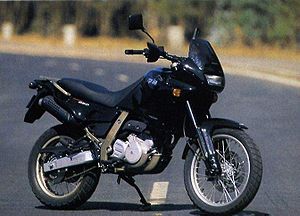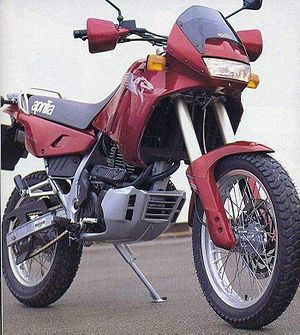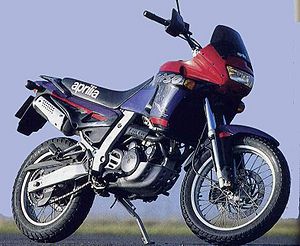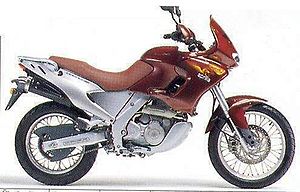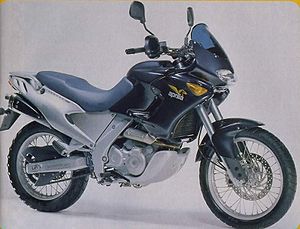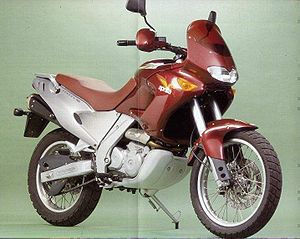Aprilia Pegaso 650/reviews
Bike Magazine of 1994[edit | edit source]
APRILIA MADE A few changes when it turned the Pegaso 600 into a 650. It kept the name and threw away everything else. Not always a tip for the top, especially when you're hurling away a device as able as the 600.
But Aprilia's corporate hand was not to be stayed, and the 600 bought it. And in the middling-sized empty space left by everything carried over from old to new (a couple of screws, three spokes and a bent pin) a Remarkably Wonderful Thing happened.
A beam frame of unmitigated loveliness was crafted in alloy and filled with a spanking new Rotax-built motor. Unfortunately there isn't a picture to show you how compact this arrangement is, but if you imagine a smallish fruit juice carton leant upon by a largish bear you'll get an inkling of an idea. Bijou and angled is the result, and this must in many ways contribute to the taught, balanced handling. An object lesson in where to put an engine and what to put around it.
The motor itself has liquid-cooling and five valves per cylinder. Since it only has one cylinder, it only has five valves which is one more than your average four-valve motor and is supposed to let it breathe better at high revs. So rather strangely it's the midrange that singles out this single.
There is a big fat lump of it from 1500rpm to 6000. Actually, that isn't so much midrange as all-the-range. There's the customary wheezing through the final thou and seismic juddering below 2500rpm, but the engine is still among the most powerful singles on the market.
And if Aprilia is not off to a bad start with the motor, then the rest of the bike is no duffer either. Aprilia stands a good chance of losing Italian manufacturers their reputation if it keeps making fuel level warning lamps which work, a neutral light that only illuminates when the bike is in neutral and a relaxed feel to the controls. The Pegaso really is very well thought out: bodywork slotting together in a quality way, chromed fork-sliders, neatly sculpted rear-end (oh, token bad point, the rack isn't plastic coated), comfortable seat, decent pillion pegs and grabable grab handles.
The only unreservedly Italian hang-up is the outstanding styling. Front and rear are future-shock chunk; side-on shows balance and poise; the rider's eye sees defensive bulk. Subtly cutting-edge design; not muscular, not massive, certainly not petite. If any bike deserves a black-and-white Design Council Award, it's the Pegaso.
The suspension is Aprilia-esque in that it eases as the mileage climbs. Early stiffness gently gives way to a firm, controlled ride which is all street and no dirty play. By all means take a Pegaso green-laning but it's a silly waste of a nice piece of plastic. Apparently someone wants to take one on the Paris-Dakar; I bet there's not much original kit left before the start let alone after the first stack.
Very Good Idea[edit | edit source]
Talking of silly things, why hasn't the 650 got stainless brake hose? The 600 had it and it's a Very Good Idea when there's four miles of the stuff between the master cylinder and the caliper. The braking is strong but with a rather spongy feel as a result.
The tires deserve a paragraph all for themselves. The Pirelli MT60s are fit only for placing over the heads of those who specified them for this bike and setting fire to. They are an object lesson in how to
make a bike seem crap; it is testimony to the competence of the Pegaso that I was able to work out it was any good. All dual purpose tires are pretty bad on-road (apart from Avon Gripsters) and a total nightmare off-road, so why bother? Especially on a bike like this, which has steering so fast the rubber feels like it's going into the corner several minutes after you've turned the handlebars.
Bikes that look like this aren't supposed to flick in so quickly, so it isn't always just the tire that the Pegaso catches out. But whatever the rider inadvertently throws the way of the chassis, it copes. Are you surprised? We've already mentioned the frame; now consider the works-Kawasaki replica alloy swing-arm and the slim chance of 40bhp upsetting it.
The Pegaso 650 is heading the way of Yamaha's TDM in its outlook; almost-roadster frame supporting trail motor and trail style. I cannot tell a lie, I like the Pegaso.
Of all the singles I've ridden, it's the most useable most of the time. The fairing and motor are motorway-friendly, the weight, poise and motor make mean-streeting a snap, and the suspension, braking, steering and motor (I like the motor) make the Pegaso a real contender for any future bumpy back-roadster of the year award.
Oh gosh, I almost forgot something. Because the Italian economy is vying with our own dear Treasury to produce the most hopeless set of figures in recorded history, Aprilia UK have no option but to sell the Pegaso at £3995. Which, if you consider the price/value index of your average Italian object (Cor-netto, Ferrari, a Coke in the Piazza del Campo) is astoundingly good value. In fact, if you ignore the Italian factor and look at the Pegaso 650 as a motorbike which is rather good, it's a bloody bargain. Roll on 1994 and the chance to put it head on against the BMW F650. I suspect they're both winners.
Motorcycle.com[edit | edit source]
The Pegaso is Aprilia's entry into the popular middleweight trail-styled bike, and while the off-road capabilities of the Pegaso are limited, its long-travel suspension, off-road styled tires and narrow chassis make it well-suited as a town and back-roads bike. Hidden behind the swoopy fairing is a modern liquid-cooled single-cylinder engine. The Rotax-based design uses a five-valve cylinder head and Sagem electronic fuel-injection to produce almost 37kW (50bhp), with a balance shaft to reduce vibration. A five-speed gearbox drives the 130-section rear tire through a chain drive, and twin underseat silencers give a sleek tail unit design. Aftermarket hard luggage systems make the Pegaso a decent middle-distance tourer.
| “ | Ever since 1976, when Yamaha's release of the XT500 created a market for what was loosely termed "dual-purpose" motorcycles, Europe has had a love affair with this class of bike. | ” |
Glamorized by events such as Paris/Dakar, the Trans-Sahara multi-stage North African rally, huge numbers of replicas were sold. However, these were replicas of form, not function -- the Sahara desert being as alien to them as Laguna Seca Raceway would be to an Electra Glide. But most owners of dual-purpose bikes aren't concerned with off-road capability anyway, as statistics have shown that for 95 percent of these bikes, the closest they ever get to a loose surface is the inevitable close encounter with dog turds that litter European cities. In the never-ending search for niche markets within a niche market, a new variant of this type of bike has been evolving. The basic design parameters of wide bars, high seat, long suspension, narrow frame, and single cylinder 4-stroke engine have been taken and worked into models that owe more to high-tech industrial design than the sand dunes of the Sahara. An excellent example of this is Aprilia's Pegaso 650-3, now into its third stage of the evolutionary cycle.
Aprilia has been selling large-capacity dual purpose machines for more than 10 years. First came the ETX600 and later the Tuareg, both bikes using the same 2-valve engine supplied by Austria's Rotax company. In 1993, the first Pegaso was introduced, with cosmetics that took it sharply out of the dirt and into the city. It also saw a change of engine to the 5-valve water-cooled Rotax engine that is still present on this latest version. Brembo disc brakes appeared on the second version of the Pegaso in 1995, along with a quieter exhaust to meet EEC regulations and updated graphics. Beyond the cosmetics that have once again been updated for 1997, biggest changes for the "-3" variant are its new frame with 1.5 cm longer wheelbase, increased rake and trail and a revised airbox.
Just as its predecessors, this bike is a lot of fun to ride. Nail the throttle and its Rotax engine pulls very cleanly, spinning through to the 7500 rpm redline more quickly than you'd expect from a large capacity single. Aggressive use of the clutch will lift the front wheel, but you have to consciously flog the engine to make this happen. Claimed power output is 49 bhp at the crankshaft, and the engine feels strong, so we were surprised when a run on a Dynojet dynamometer showed just 40 bhp. Our machine probably feels stronger due to its fat spread of torque from 3500 to 6000 rpm. It is also versatile enough for riders too lazy for frequent gear changes. Let the revs drop down under 3000 rpm, snap the throttle open and the Pegaso will shudder through 3000 rpm and pull normally up through its powerband, that starts at 4500 rpm.
A balancer-shaft is intended to damp out vibrations, but it is only partially effective. Footrests start to tingle at 4000 rpm, and quite sharp vibrations are felt at the bars and seat from 6000 rpm. The only other minor criticism of the otherwise excellent engine is a slight surge when riding under 4000 rpm. It doesn't actually stumble, but feels like it might. Only five speeds are offered from the gearbox, although a sixth gear would allow higher-speed cruising under the band of engine vibration. The Pegaso's clutch is very light and the gear changes slick, its only glitch being a false neutral between third and second when downshifting with the bike stationary.
Changes to the Aprilia's chassis have resulted in a slightly slower-steering bike. It is still very nimble through traffic, and although requiring a little more work, cuts through corners with excellent stability. The Michelin TX66 tires fitted to our test machine have a very light off-road pattern and worked exceptionally well on tarmac, allowing you to crank the Pegaso over to sport bike angles without a hint of traction loss. With its high footrests and no center stand, ground clearance is endless. You'd have to be very close to running off the edge of the tires before anything touched down.
Taking a gentle detour through the woods along a hardened fire-road has the Pegaso coping reasonably well. Unfortunately, the inverted Marzocchi forks are quite soft and cannot be adjusted, while the Boge rear shock has a virtually inaccessible rebound damping adjuster. Quicken the pace, or move into rougher terrain and the suspension is quickly overwhelmed. Avoid heavy sand at all costs. The Michelins can't cut through it and the bike digs itself in. Suddenly its 352-pound weight feels more like 600 pounds and you're trying to heave a full-dress 'Wing out of kitty litter.
With a fuel tank that hold 22 liters of unleaded and an engine that gulps at a miserly 16 to 20 Km per liter (39 to 50 mpg), you can expect a range of about 400 Km (250 miles). Owners will be praying it were shorter, as one thing Aprilia has not got right is the Pegaso's seat. It feels luxuriously soft as you first ease yourself into the saddle, but after an hour you begin to feel like you're sitting on the upper frame tubes. Spend a day in the saddle of the Pegaso and you'll need a week to recover. Strange really, as Aprilia clearly had some light touring in mind, as witnessed by the optional set of hard-shell cases that clip straight on to its standard rack. A handy centerstand is also offered as an accessory. The really dedicated owner can also splash out for an optional fully adjustable rear shock, with remote reservoir for dialing compression and rebound damping.
Overall the Pegaso is a pretty decent motorcycle, but who exactly buys them? Aprilia's new Pegaso is selling very well, but the customer is difficult to characterize. They are not generally first-time buyers. It would make an excellent commuter vehicle, except it also sells well in Northern Europe where it always seems to rain during morning rush hour, discouraging two-wheelers. The seat is a little tall, making it less attractive to women, although like BMW's F650, a kit is available to lower the seat even further. There is too little left of the dirtbike heritage to attract the Dominator/XT/DR/KL rider. It doesn't have the pace of a sportbike, or the comfort and smoothness of a tourer.
Perhaps, we might just be witnessing the birth of a new type of market segment -- the Urban All-rounder -- visually impressive and flexible enough to be used for many different roles. BMW's F650, following the same concept and built by Aprilia using the 4-valve Rotax engine, has been a great success - but most likely as a result of its tank badge. The fact that Suzuki has introduced a very similar bike called the Freewind this year suggests that they too believe a new segment is emerging. It can be said Aprilia was in there at the start, and have given the rest of the world a tough act to follow with their Pegaso 650.
